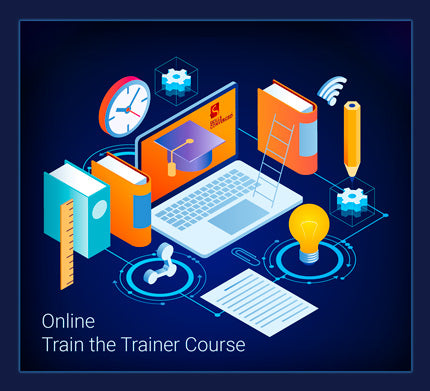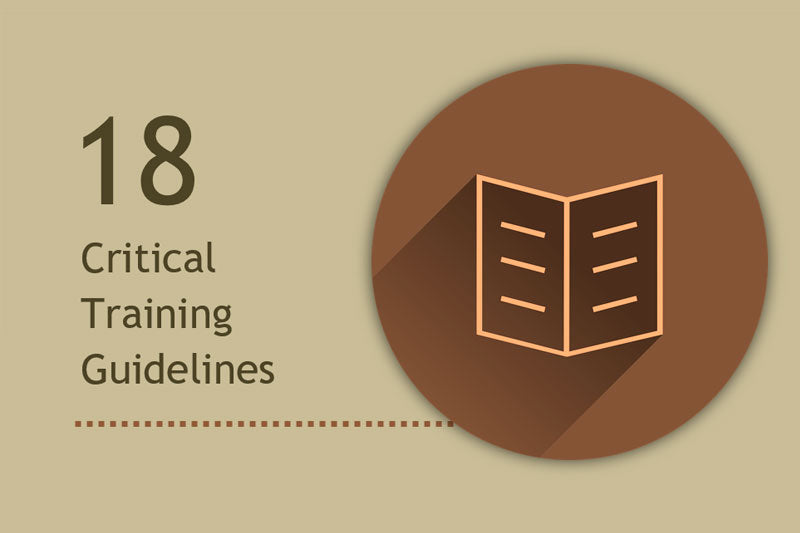Learn about the seven fundamental principles of training and what you must absolutely get right to be able to deliver effective training. Here, you will learn about training needs analysis, working memory, long term memory and how learning works.
You are a subject expert and you have decided to teach. Welcome to this crash course on training. You know your field well, but you are wondering what you should consider when it comes to training people. You could be engaging in a formal training course, or just informally training someone on the job. The principles are the same for both. Once you know how humans learn, you can deliver great training on anything.
To run a great course, you need to get three things right:
- Understand what the delegates need
- Match an already designed course to their needs or design one from scratch
- Deliver an impeccable course to gain long term results
That’s it, that’s all it takes.
Except, from experience, we all know that many courses don’t quite deliver. How many courses have you attended that the trainer didn’t even ask to see what you already know and went on a boring monologue; you couldn’t even get a word in to say, “Please stop, I know all this stuff, what I wanted to learn is this other thing!”
Or similarly, how many times have you attended courses where you think the trainer would rather be anywhere else but there teaching you. The trainer doesn’t care about the topic, they treat it just as a job and them and the course content is forgotten just as quickly.
There is a way to avoid all of this by approaching training systematically. It is as if you have to apply the same medicine to yourself. The purpose of this article is to walk through the major components of training so that you can quickly become familiar with them.
So, let’s start with delegates’ needs first.
What Is TNA?
Imagine yourself as a doctor who is trying to prescribe treatment without looking at symptoms or diagnosing the disease. In such a case even the most recent and developed treatment can prove to be useless or even harmful to your patients.
Training is about reprogramming the brain. It is about gaining new habits, losing bad habits and replacing them with better ones. It is about helping people to question their beliefs and behaviours, some of which they might have had for years. If you don’t spend enough time understanding the underlying nature of your delegate’s needs and problems, your training will be a waste of time.
Your choice of action depends on the type of training you are offering:
- Public courses, where the course is predesigned.
- Here, you already know what you want to cover, and they are coming to learn it. You must therefore spend time at the beginning of the course and at the beginning of each session or topic to see what they want. We call this Establish the Need, which is a systematic five-step process to understand their world so that you can meet their needs. Establish the Need, and systematic structuring of a course is explored in detail in our Online Train the Trainer Course.
- In-house course, where you will tailor training to their needs or design a course completely from scratch.
- In the training industry, this is usually carried out with what is known as a Training Needs Analysis (TNA). This is a step by step systematic approach where you analyse their strengths and weaknesses in a given area and formulate training solutions to address any weakness. Training Needs Analysis is explored in detail in Chapter #5 of the book Train the Trainer: The Art of Training Delivery along with step-by-step guidelines on how to carry it out.
How to Meet Training Needs Quickly
For public courses, you would need to have your predesigned training content that you can use to teach from. For in-house courses or any that you have ran a TNA, you would identify the needs of your delegates and devise a Training Plan. You would then need training content that matches this plan. You could start with predesigned course content or completely design something from scratch.
Most often, trainers start from predesigned courses. The reason is partly cost (which can be enormous if you have to design a course starting from a blank page) and partly using content that they already have and know that works. Recall that, to run a great course, the third element to get right was impeccable delivery. Most often, trainers prefer having familiar content, so they know how best to deliver it.
For classroom and interactive training. The training content usually consists of slides, workbooks, exercises, games, etc. that should be used to help “reprogram” the delegates during the course. Having state-of-the-art training materials means you can use the latest findings and research to help your delegates get the best from your course.
You then have three choices:
- You can develop your own training materials, which usually takes years to perfect. You need to be aware of the field and the latest developments both in subject matter and also in training delivery and learning.
- Alternatively, you can buy training materials from suppliers such as us. This allows you to take advantage of the expertise of people who specialise in the production of such content.
- The third and perhaps the best choice would be to combine both of the above choices. Obtain editable training materials, tailor them based on your delegates’ needs and improve the course each time you deliver it as you become more experienced and comfortable with the content.
Our training materials are designed in such a way to accommodate the last two options mentioned above. You can obtain off-the-shelf training materials on soft skills and management from us and deliver it without the need to make any changes. All you need for an effective course is provided. You just have to rehearse it and master the delivery. You would need to follow the Establish the Need process in the course so that you can tailor your delivery accordingly and meet their specific needs.
Alternatively, having obtained ready-made courses, you can add your own content or tailor what is provided to create a more personalised training course. In a way, it helps you leverage the time and money we spent developing a course, so you can obtain affordable courses quickly and meet market demand.
Not all training materials are good. We have therefore compiled a guide on buying training materials from any suppliers that helps you see what elements are important so that you end up with a great course whoever you obtain them from.
What Is the Ultimate Objective of a Trainer?
Ultimately, you want the delegates to say that, “this was the best course I ever attended”.
To achieve this, you need to make the course memorable. This means getting them to experience something they normally don’t. You want them leaving the course, rushing to friends and family and telling them about the experience, just because they had a good time, they learned something useful and you made them think.
This is why we focus so much on providing engaging games, training exercises and example conversations in our courses and on this site. It’s because they work; we have seen the results in the field. They help delegates fully absorb the content and remember it well into the future.
Good trainers should be able to come up with new tools as the course unfolds in order to respond to specific new needs that are highlighted. You must therefore be aware of all instructional methods and their pros and cons, so you can use the right tool as needs arise.
In addition, a large database of exercises, training content, stories, conversation examples and so on can also help you find the right instrument. For this, we provide one of the largest collections of free training resources and exercises on the net.
How to Become an Effective Trainer
The third important factor in the success of a training course is you, the trainer. Countless surveys collected by training companies suggest that what makes a training course especial is largely to do with the performance of the trainer.
We think they are right.
A good trainer is not necessarily one who knows more about the course topic than anyone else. A good trainer is not necessarily the world’s best expert in a given field. The critical skill of a good trainer is the ability to teach and understand delegates. This is a skill, it can be learned and mastered like all other skills. In other words, when it comes to teaching, it pays to become better at teaching than to become a world expert on, say, emotional intelligence, or even aiming to become the most emotionally skilled human!
Teaching is a skill that can be mastered, and like any skill requires knowhow and practice. There are three approaches and we cover all by providing the following resources to you:
- Read about it: Best-selling train the trainer book
- Attend a training course: Interactive train the trainer courses
- Learn on your own: Learn to teach with train the trainer online course
A great part of learning how to teach well, is to understand how human learning works. In the past three decades, there has been much progress in the fields of pedagogy, educational psychology and cognitive psychology. Computers and the information era have given us enormous insight on how information processing works leading to exciting new theories on how human brain functions.
It is now accepted that learning is effectively a long-term change in memory. To make training work, you need to “make it stick”.
That’s all.
Any which way you get there doesn’t matter. All you want is that the method requires minimal effort while making a person remembering it for longer.
So, let’s look into this a bit more since it is central to training.
How Learning Works
Consider a group of people you have just been introduced to. Suppose you want to learn the names of everyone in the group, so you can remember the name of any person if you see them six months later. We all know the powerful effect of our names, so it’s a wonderful skill to have. On paper, this is a simple learning activity, but as we all know, remembering the names of a large group can be quite daunting.
The key to learning and long-term memorisation is repetition. The more we repeat, the more and faster we learn and the longer we remember it.
In the naming example above, psychologists Catharine Fritz and Peter Morris carried out the following interesting study to examine the effect of repetition (Morris and Fritz 2000). They got a group of college students to form a circle of nine students each. In each circle, one student said his name. The person on the left, said the name of this person and then added his name. The next person repeated the first two names and then added his own name and so on until the last person had to say everyone’s name. After several repetitions where each student started the cycle, they began to fully memorise all of the names.
The results were staggering; 30 minutes after the repetition exercise, 75% of students could recall all the names. After two weeks, 40% of students could recall all the names and after 11 months, 27% of students could recall every single name! This was all achieved by a simple verbal repetition exercise carried out in one session. Though, you can also see, the results after 11 months were not as ideal as we may like. What can we do to improve this long-term performance too?
Why Repetition Works?
Further research by neuroscientist confirms that continuous repetition leads to a fundamental change on a neural level. It is well known that learning takes place when new connections are made between brain cells. A new research as demonstrated by Dr. Joe Tsien shows that especial communication channels in our brain nerve cells called NMDA can facilitate the process of learning (Lee and Tsien 2009). When a nerve signal passes from one cell to another, a “receipt” is sent back to acknowledge that the signal has been received. This receipt is picked up by other nearby nerve cells that were firing at the same time.
The mechanism of exactly how this works in practice was presented by Prof. Aryeh Routtenberg and co-researchers (Holahan et al. 2007). When a nerve signal crosses the gap between two nerve cells, a “receipt” molecule is sent back by NMDA receptors to acknowledge it. The receipt molecule activates certain proteins known as GAP-43 which in turn makes it easier for the next signal to pass through. In other words, the more you repeat and the more you fire specific neurons, the easier it gets for the signal to pass through and create a better connection.
This leads to the ultimate magic; the more you repeat, the easier it gets to learn.
What Is Spaced Repetition?
The above learning technique that greatly relies on the neural learning mechanism explained above is known as spaced repetition. The method is simple: Keep learning repeatedly with increasing intervals of time in between the learning attempts. Each learning attempt fires the appropriate neural connections and makes them stronger. The technique also relies on what is known in psychology as the spacing effect; we learn a list much better if we repeatedly study it over a long period of time as oppose to a short period of time.
There is an interesting explanation for this, known as deficient processing view. It suggests that the short-time repetitions are not as effective because we get bored while going through the same exact material repeatedly over a short amount of time and hence pay less and less attention to it. There is also minimal variation in the way the material is presented to the brain, when it is repeatedly visited over a short time. This tends to decrease our learning. In contrast, when repetition learning takes place over a longer period of time, it is more likely that the materials are presented differently. We have to retrieve the previously learned material from memory and hence reinforce it. All of this leads us to become more interested in the content and therefore more receptive to learning.

How to Apply Spaced Repetition to Training?
To gain various benefits of spaced repetition and repeated learning in the context of a training course, we have devised a method at Skills Converged that we call “Try, Practice, Demonstrate”. Repetition can be applied in three distinct levels:
- Teaching a specific skill. In this case we use Try, Practice, Demonstrate to get the participants try a specific skill three times; first try it on their own while a trainer observes, then practice based on the guidelines provided by the trainer and under supervision, and finally demonstrate the skill in a simulated test environment and get judged on the quality of the performance. Our experience shows that this triple-attempt repetition is incredibly effective in learning and memorising a technique.
- Covering a specific topic over the entire course. This method widens the repetition interval to that of a day, usually the duration of a training course. A specific topic or technique is covered repeatedly throughout the entire course, from different perspectives, to increase variation and interest. Repeatedly visiting the topic in different contexts helps the participants remember and recall the subject while associating it with other topics. This helps them to reinforce similar neural paths in their brains which further boost learning.
- Covering a specific topic over a period of time. Through multiple courses or a course over multiple days, participants can be exposed repeatedly to a specific skill. Each attempt helps them recall the topic they were thought, possibly with the triple Try, Practice, Demonstrate, and go over it again. This allows participants to re-evaluate their current performance, think of how they can improve it, avoid falling back to bad habits and get a fresh take on the skills to become more conscious of them.
In soft skills topics that we cover extensively, the spaced repetition techniques, in conjunction with our Try, Practice, Demonstrate methodology is incredibly effective. Communication skills and interpersonal skills are notoriously habitual, and it will certainly take more than a mere awareness to change a lifelong behaviour.
What Are the 7 Principles of Training?
As a trainer, your role is to maximise learning. Delivering a course can be hard work. It requires preparation and careful planning. You need to spend valuable time during the delivery as well as before the course. Having gone through all the effort, if your delegates don’t learn anything new or forget most of the lessons taught shortly afterwards, you might as well not bother with the training.
To deliver a useful training course, you must consider the seven most important principles of learning. Without keeping these critical principles in mind, you risk delivering a poor course, alienating your delegates from the training subject and wasting your own time in the process.
The 7 principles are as follows:
Principle 1:
Attention Span is Limited
People’s attention span is limited. With so much going on in the world and the ever-increasing number of “stuff” to pay attention to, patience is running thin.
Research shows that people become increasingly more interested in a topic within the first 10 minutes of being introduced to it. However, after 10 minutes their attention drops sharply. Within 30 minutes you will be struggling to hold much attention.
What does this mean for your training? Get to the point quickly when you introduce a subject. Next, move on to a related topic swiftly to keep them engaged and keep them following you along.
To keep their attention, you cannot risk delivering a passive course. You must use frequent training exercises and discussions that increase participation.
Principle 2:
Learning Requires Motivation
Recall from your past experiences that if you were not interested in a topic, how easy or difficult you found the topic. It is most likely that you found it hard when you were not interested.
Similarly, unmotivated leaners don’t learn. People lose interest when they don’t know why they need to learn something. This is crucial when teaching adults. We cannot stress this enough. If delegates don’t know what you are trying to get at, their attention wanders off. Soon they will be on their mobile phones shopping for shoes or checking their social media feeds.
Make your content engaging. Always follow this proven technique when teaching someone on any topic:
Tell them what you are going to tell them
Tell them
Tell them what you just told them
Let’s call this TTT. As it happens, it sounds very much like Train the Trainer (also known as TTT). There you go—you should never forget this now; apply TTT every time you Teach. It’s T’s all around…
Principle 3:
The Learning Curve is Not Flat
People don’t learn about a given subject at a constant speed. There is always a learning curve involved while learning anything. As learning continues, people’s progress starts to slow down as they reach a plateau. Learners need to become confident about what they have learned and relate this to everything else they know, which is why they reach a learning plateau. After spending some time in the plateau, learners can follow a second learning curve and move on to more complex topics.
As a trainer, you must be aware of learning curves and how individual they are. Some people might be quicker to learn but require more time to reach the plateau. Others might learn slowly, but once they “get it”, progress rapidly. When running a training course, awareness of the learning curves is crucial since a training course is, by definition, more interactive than a lecture and hence tailored to an individual’s skills, knowledge and learning capability.
In practice, this means that the course should contain a lot of hands-on exercises to allow delegates progress on their own while being supervised and coached by you, the trainer. Periodic discussions and question/answer sessions will help learners reach their learning plateaus and get ready for the next phase of learning.
Principle 4:
Short Term Memory is Limited, Long Term Memory is Limitless
Over the years there has been a great deal of research on human memory. It is now well established that human memory works based on two related systems:
-
Short term memory.
- There has limited capacity. You can hold about 7±2 items depending on circumstances or the individual. This was first shown by George Miller, which led to the magical number 7, plus or minus 2 (Miller 1956). Although recent research indicates that a more realistic figure is 4±1 units (Cowan 2001).
- There is limited duration. Short-term memory decays fast. You can hold information for about 15 to 30 seconds without a form of rehearsal (Atkinson and Shiffrin 1971).
- The encoding is mainly acoustic. We tend to use sound for short term memory, even coding visual information into sound.
- Long term memory. Our long-term memory is somewhat unlimited. For example, research by Tony Buzan shows that if an individual is shown 10,000 images and then is shown a control image, he can accurately tell whether the control image was part of the collection or not! Amazingly, even if the control image is inverted or flipped, the success rate is still very high (Buzan 2009). The research in this area shows that humans are highly visual and that our visual memory is quite strong. This led Buzan to invent mind mapping, to help visualise information and hence improve recall.
So, here is when it gets interesting. Recall that learning is defined as change in long-term memory. The path to long-term memory is through short-term memory. Now as you have seen, short-term memory seems to be very fussy—limited and fast decaying.
To strengthen holding items in memory, you have two powerful techniques at your disposal:
- Chunking. This is about grouping units into a cluster, so you can store a bit more in your short-term memory.
- Rehearsal. Mentally repeating helps keep an item in short-term memory for longer. Rehearsal is the key to long-term memory and subsequently learning.
So, how does this apply to training?
When it comes to long-term learning, the transition from short-term memory to long-term memory is critical:
- When presenting content, aim to present it in no more than seven parts. Help learners to familiarise themselves with smaller number of concepts quickly and efficiently so they are not overwhelmed.
- Use repetition and rehearsal, both short term and long term, along with spaced repetition, and visualisation for your delegates until the content is fully memorised.
This principle also suggests why we cannot learn too much too quickly. Trainers who cram a course or lecture with tons of content thinking that they are delivering a comprehensive up-to-date course are making a big mistake. Learners cannot take it all in as their short-term memory gets saturated and your effort will be wasted.
If you want to impress them or make them aware of some content, much like a presentation, this approach is fine, but don’t expect long-term learning. That only comes with rehearsal and practice. And as you might have heard, mastery comes with 10,000 hours of rehearsal, in the form of deliberate practice (Ericsson et al. 1993). You cannot cheat your own brain, nor those of your delegates! As the old saying is—no pain, no gain.
Principle 5:
People Have Different Learning Styles
People learn differently. There are many learning styles systems, such as Kolb’s Learning Style Inventory, Fleming’s VAK, Honey-Mumford Model, Gregorc Model, 4MAT, Howard Gardner’s Theory of Mind and many others. In addition, you also have numerous personality type systems categorising humans into various types—a famous one being MBTI (Myers-Briggs Type Indicator).
The essence of all these models is to make you aware that you cannot treat everyone the same. For example, in the VAK model, people generally have one of the following preferences:
- Visual. They like to see images, diagrams, words and illustrations to understand a given concept.
- Auditory. They like to listen to an explanation.
- Kinaesthetic. They like to learn by doing. For example, they prefer to hold an object in their hands, examine it and interact with it.
A good trainer should consider a variety of tools and methods to match a variety of learning styles. Accommodating all methods might not always be possible but it is possible to simulate conditions to cater for certain preferences by carefully planning and designing training materials and interactive exercises that meet each style’s needs.
Principle 6:
Feedback Is an Essential Part of Training
Learning can be difficult and tiring. To keep learners motivated, a trainer must provide adequate and relevant feedback. However, not all feedbacks are good. When giving feedback, consider the following:
- Your feedback must aim to motivate rather than discourage or scare a leaner.
- Your feedback must make the learner feel more confident, not to destroy his self-esteem.
- Your feedback must be specific so the learner can benefit from it. A generic “You are doing well” might not be registered at all.
- Your feedback must reinforce new learning points and discourage old and bad habits.
- Your feedback must indicate the present state of learning to the learner and provide a way forward for the learner to move on to the next level.
Trainers must always be aware of the incredible power of positive feedback in encouraging learners to challenge themselves and push forward until they learn new concepts or techniques. A trainer’s role here can be critical since without feedback, learners would not know if they are doing well or which direction they should go next. Lack of adequate and specific feedback can considerably slow down the learning process and goes against the principles of accelerated learning.
Remember, 60% of factual information will be forgotten within 2 days if what was learned is not reviewed or rehearsed. Periodic review is much like a self-feedback. It is critical that leaners know about the potential memory loss. Properly designed training must consider this and provide course follow-up and action plans to reinforce learning and prevent learners from forgetting the content quickly.
Principle 7:
Take Advantage of All Senses
Humans have five main senses. The primary ones for visual, sound and touch. Rather than appealing only to one of them such as sound, training can be greatly improved if all senses are engaged. This requires careful planning, use of quality training materials and introduction of interactive exercises that encourage use of other senses such as touch.
Conclusion
To summarise this crash course on training, to deliver a good course considering the following:
- You must Establish the Need before you embark on training anyone
- Attention span is limited, you must utilise methods to keep them engaged
- Get to the point quickly
- Short-term memory is limited and can be overwhelmed
- Use chunking
- Use repetition and rehearsal
- Use spaced repetition
- Appeal to visual brain and other sensors
- Structure any training using the TTT formula
- Apply Try, Practice, Demonstrate throughout your course
- Understand that delegates have different learning styles
- Make sure there is a feedback loop present which usually means you need a way to measure performance
Following these powerful guidelines allows you to provide fanstaic training courses that are well remembered for years to come. The training will prove to be a good expenditure of both your time and the learner’s time and of course, if your training is good, people will keep coming back for more.
Ponder over the above guidelines and score yourself from 1 to 5 on how much you use each or are aware of it while teaching. If you are not happy with your score, find out what you can do to improve your training delivery and take immediate actions.
Remember the last guideline above on measurement; if you want to improve your own training performance, you got to measure it—then you know what to do to improve it.
References
Atkinson, R. C., & Shiffrin, R. M. (1971) “The control processes of short-term memory. Institute for Mathematical Studies in the Social Sciences”, Stanford University.
Buzan, T. (2009) “The Memory Book: How to Remember Anything You Want”, BBC Active, ISBN: 978-1406644265
Cowan, N. (2001) “The magical number 4 in short-term memory: A reconsideration of mental storage capacity”, Behavioral and Brain Sciences. 24: 97–185. doi:10.1017/s0140525x01003922. PMID 11515286.
Ericsson, K. A., Krampe, R. T., & Tesch-Römer, C. (1993) “The role of deliberate practice in the acquisition of expert performance”, Psychological review, 100(3), 363.
Holahan MR, Honegger KS, Tabatadze N, Routtenberg A. (2007) “GAP-43 gene expression regulates information storage. Learning & Memory”, (Cold Spring Harbor, N.Y.). 14: 407-15. PMID 17554085 DOI: 10.1101/lm.581907
Li F., Tsien JZ. (2009) “Memory and the NMDA receptors.” N Engl J Med 2009; 361: 302–303.
Morris, P.E., Fritz, C.O. (2000) “The name game: Using retrieval practice to improve the learning of names”, Journal of Experimental Psychology: Applied, Volume 6, Issue 2, P 124.
Miller, G. (1956) “The magical number seven, plus or minus two: Some limits on our capacity for processing information”, The psychological review, 63, 81-97.

About the Author
Dr Ethan Honary is the founder of Skills Converged Ltd. A training consultant, researcher, author and designer with an aim to help trainers worldwide to improve training delivery and course design.
Table of Contents
How to Meet Training Needs Quickly
What Is the Ultimate Objective of a Trainer?
How to Become an Effective Trainer
How to Apply Spaced Repetition to Training?
What Are the 7 Principles of Training?
Principle 1: Attention Span is Limited
Principle 2: Learning Requires Motivation
Principle 3: The Learning Curve is Not Flat
Principle 4: Short Term Memory is Limited, Long Term Memory is Limitless
Principle 5: People Have Different Learning Styles
Principle 6: Feedback Is an Essential Part of Training
Principle 7: Take Advantage of All Senses
Course Design Strategy
Available as paperback and ebook
Online Train the Trainer Course:
Core Skills
Learn How to Become the Best Trainer in Your Field
Train The Trainer Book
Available as paperback and ebook
Explore Topics
Longform Train the Trainer Guides
All In-Depth Articles
CPD Accredited
Online Train the Trainer Course: Core Skills
Learn How to Become the Best Trainer in Your Field
Full Course Details
How to Reference This Article
Honary, E. (2019) "How to Deliver Professional Training", Skills Converged. Retrieved from: https://www.skillsconverged.com/blogs/train-the-trainer/how-to-deliver-professional-training












Leave a comment
All comments are moderated before being published.
This site is protected by hCaptcha and the hCaptcha Privacy Policy and Terms of Service apply.